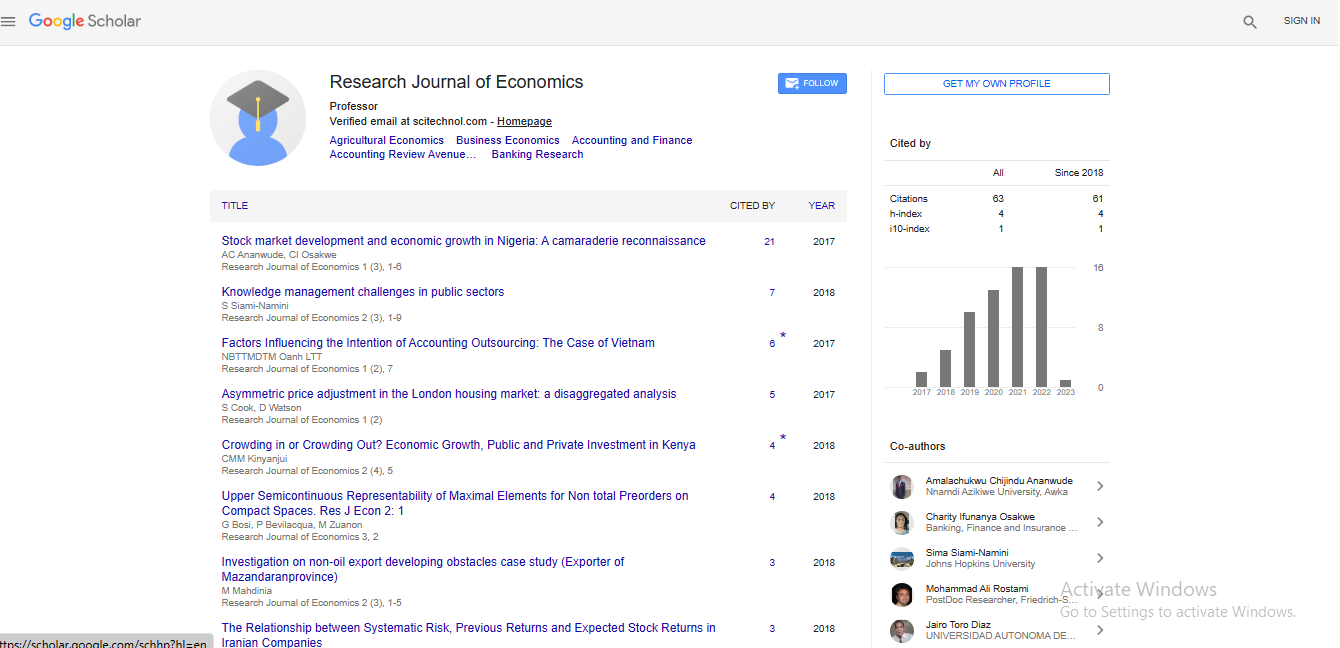Perspective, Res J Econ Vol: 8 Issue: 1
Business Cycles and Division in Economic Explosion and Recession
Gerird Grieven*
Department of Economics, University of Namur, Namur, Belgium
- *Corresponding Author:
- Gerird Grieven
Department of Economics,
University of Namur,
Namur,
Belgium;
E-mail: gerird_grieven@gmail.com
Received date: 04 November, 2023, Manuscript No. RJE-23-119229;
Editor assigned date: 06 November, 2023, PreQC No. RJE-23-119229 (PQ);
Reviewed date: 20 November, 2023, QC No. RJE-23-1192279;
Revised date: 15 July, 2024, Manuscript No. RJE-23-119229 (R);
Published date: 22 July, 2024, DOI: 10.4172/RJE.1000173
Citation: Grieven G (2024) Business Cycles and Division in Economic Explosion and Recession. Res J Econ 8:1.
Introduction
There are different definitions of what constitutes a recession, one definition is "a significant decline in economic activity spread across the market, lasting more than a few months, normally visible in real GDP, real income, employment, industrial production, and wholesaleretail sales." Another definition is "two quarters of negative GDP growth." The welfare of the general public as well as private entities is impacted by the shifts in economic activity that defines business cycles. Usually, changes in a broad economic indicator, such real gross domestic production, are used to measure business cycles. A wide range of macroeconomic indicators often experience general upswings and downturns throughout business cycle changes. The length and intensity of the different expansion/recession events vary throughout time. Their periodicity often spans a large range, from around two to ten years. This type of process is sometimes referred to in statistics as a "stochastic cycle". Their mathematical analysis may truly take into account this adaptable knowledge about the frequency of economic cycles by employing a Bayesian statistical paradigm.
Description
Economists use the phrase "business cycle" to characterize the rise and fall in economic activity across time. The economy is made up of all the firms, labourers, and customers that create, exchange, and use commodities and services inside. Thus, the business cycle is defined as the quantity of production that can be quantified. Businesses require additional workers when their output rises.
The movement of economic indicators throughout each cycle phase and the alternating stages of growth and contraction in overall economic activity are the main characteristics of business cycles. The official determination of business cycle peak and trough dates uses key coincident economic indicators, namely industrial production, employment, income, and sales. These indicators collectively represent aggregate economic activity and are referred to as real (i.e., inflation-adjusted) GDP, a measure of aggregate output. Recessions are essentially a particular kind of vicious cycle, wherein there is a fast spread from sector to industry and region to region due to cascading decreases in productivity, employment, income, and sales. The movement of these coincident economic indicators and the recession's endurance are fuelled by this domino effect, which is essential to the spread of recessionary weakness across the economy.
The economy grows relatively quickly during an expansion, interest rates are often low, and output rises. The employment and wage situation, corporate earnings and output, aggregate demand, and the supply of goods and services are all growth-related economic indicators that typically exhibit consistent upward trends throughout the expansionary period. The economy continues to have a solid money supply, and money is still relatively inexpensive. However, during the stage of economic expansion, the expansion of the money supply may cause inflation.
In a business cycle, the growth is followed by the peak period. The point in the business cycle when important economic indicators begin to decline is known as the peak. Prices are at their highest point right now, and there is a risk of an economic “overheats," which means companies will be unable to meet demand from customers. Peak growth usually leaves the economy with certain imbalances that need to be fixed. Because of this, companies may begin to analysis their spending plans and budgets when they think the economic cycle have peaked.
Conclusion
When employment declines, growth slows, and prices remain unchanged, a correction takes place. Businesses could not promptly change production levels in response to declining demand, which might result in oversaturated markets with excess supply and a decline in pricing. A depression might develop in the recessionary atmosphere if the contraction doesn't stop. In this phase, entrepreneurs concentrate on discovering methods to enhance their financial status, including reducing expenses or boosting their competitiveness.
When the economy reaches its lowest point and both supply and demand reach their lowest points prior to a rebound, the cycle trough is achieved. The cycle's low point is a terrible time for the economy because of the stagnant income and expenditure that has a negative, broad effect. The bottom gives people and companies a chance to reorganize their budgets in preparation for an upturn. Businesses frequently fire staff members or shut during a recession.
 Spanish
Spanish  Chinese
Chinese  Russian
Russian  German
German  French
French  Japanese
Japanese  Portuguese
Portuguese  Hindi
Hindi 